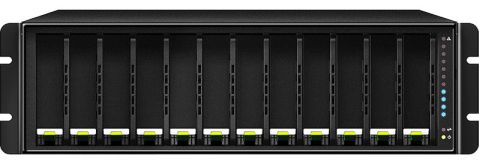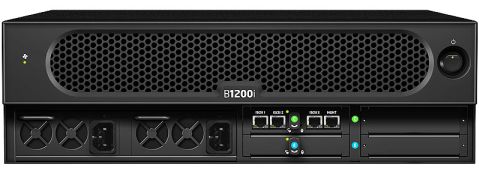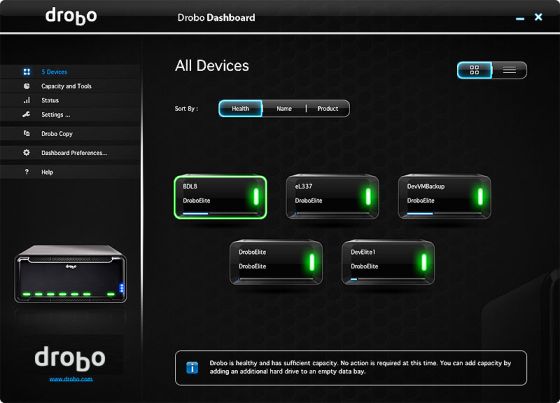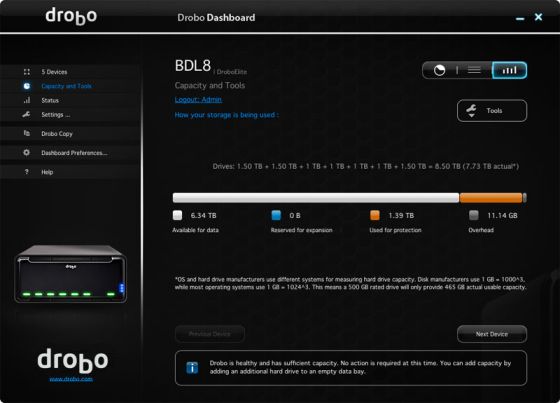![]() After a visit to Symantec HQ in the morning it was off to Drobo’s HQ. Drobo stands for Data Robotics but they have permanently moved to the Drobo name instead. There products consist of of low-end storage devices for the consumer and SMB markets. The Drobo line ranges from small 4-bay storage units up to their soon to be released 12-bay unit. Much of their presentation was focused on their new B1200i 12-bay iSCSI SAN storage and their newly designed management UI. I’ve always thought Drobo’s were attractive and well built units but I felt that they were overpriced compared to the many other similar units on the market from vendors like NetApp, Synology, QNAP and Iomega.
After a visit to Symantec HQ in the morning it was off to Drobo’s HQ. Drobo stands for Data Robotics but they have permanently moved to the Drobo name instead. There products consist of of low-end storage devices for the consumer and SMB markets. The Drobo line ranges from small 4-bay storage units up to their soon to be released 12-bay unit. Much of their presentation was focused on their new B1200i 12-bay iSCSI SAN storage and their newly designed management UI. I’ve always thought Drobo’s were attractive and well built units but I felt that they were overpriced compared to the many other similar units on the market from vendors like NetApp, Synology, QNAP and Iomega.
I’ve always felt like Drobo has had a bit of an identity crisis, they target a specific market with each of their storage devices instead of going after a much broader market. Most of their business class devices only support the iSCSI protocol which limits their use cases. Their FS line doesn’t natively support iSCSI or NFS but if you install one of their Drobo Apps on it then you can use NFS. Finally their smaller consumer units only support direct attach via FireWire or USB. Each line is marketed at a different use case and has different connectivity. This limits each device to only being used for a specific purpose. The problem with that is all of their competitors support all protocols and connectivity options across their entire line of devices. If you take Synology or NetGear for example, from their small 1 bay units all the way up to their expandable 5-bay units they support all the same features across most of their product line. This means any of their devices can support iSCSI, NFS, CIFS, FTP, AFP and much more. As a result they can be used for a multitude of things simultaneously, the Drobo units on the other hand are very limited in what they can do. I can’t see that it would be all that difficult to provide support for both iSCSI & NFS on all their devices so customers can choose what they want to use. Having consistent software and protocol support across all their devices would also make development easier.
Drobo unveiled there new 12-bay unit (B1200i) to us which fits into their “Drobo means business” theme, it looks like a larger version of their 8-bay units with a few key differences.
- Dual hot-swappable power supplies (other Drobos only have single fixed power supplies)
- Support for SATA, SAS and SSD drives (other Drobos only support SATA)
- 3 Gigabit Ethernet ports (other Drobos only have 2)
- 1 Gigabit Ethernet port dedicated to device management (other Drobos don’t have this)


I asked some questions such as if they supported 6.0 GB/s SAS drives and they said they did, which is nice, but some other answers I didn’t like so much. The first is that while they have 3 Ethernet ports, they have no ability to team them together for load balancing or failover. Each port is independent and must be assigned its own IP address, they seemed to think this was OK because users and apps could use different IP addresses to access the Drobo but I thought this was too complicated and unrealistic. The B1200i only has a single controller card but has additional empty ports for future expansion. I asked if they planned on supporting a second controller card and they said they might at some point in the future. That seemed to me like they were releasing a product that wasn’t completely done yet.
The next is the price, they had said the B1200i was going to be released at just under $10,000 half-populated with 12TB of storage. That just seems way to high for a storage unit that is missing many enterprise features and is in the same price range as the NetApp FAS2020, EMC VNXe & HP MSA, all of which are much more robust, enterprise class units. They plan on also offering a lower cost model with no/smaller drives but the price is still way too high. They need to be down around the price range of the Iomega ix12-300r which starts at $4999 for a 4TB model.
They also showed off their new Drobo Dashboard which was visually very nice looking but I felt was lacking in many areas. They were asked several questions on if it supported different features like SNMP and they kept answering that additional features would be coming later. I felt that if they were going to put all that effort into developing a new interface they should get it right before they release it. It seemed like much of the development effort went into improving the visual elements of the interface and not the functional elements. The Dashboard lets you manage multiple Drobo units that are on the network in a centralized view but seemed lacking enterprise features like AD or LDAP authentication.



The Drobos use a proprietary RAID called BeyondRAID which is the only RAID that you can use as they do not support any traditional RAID levels. You are limited to a single RAID group even on the 12-drive model. Think of BeyondRAID as kind of a dynamic, intelligent RAID level that has the ability to use drives of different sizes and types in a RAID group. The size of the RAID group can be increased simply by removing a drive and inserting a larger drive and letting the RAID rebuild itself. Being able to increase drive sizes without data loss is a nice feature but I’m not a big fan of mixing different size/type drives in a single RAID group. There is support for standby hot spares and also dual disk redundancy, also drives can be re-inserted in any order without data loss. Thin provisioning is supported but only for traditional OS volumes, it is not supported for VMware VMFS volumes.
I’d really like to see Drobo succeed but I feel to do so they need to do a few things to better compete with the many other low-end storage devices on the market.
- More competitive pricing, across your whole line, its OK to charge more if you’re offering more then your competitors but in most cases they are not.
- Feature and protocol parity across their entire product line, offer iSCSI, NFS and other features on all models from the 4-bay Drobo up to the 12-bay B1200i.
- More features on both consumer and business models, take your Drobo Apps that are only available on the FS models and integrate them in all your models. Features like FTP & CIFS support, jumbo frames, backups, rsync, AFP, SSH and SNMP should be on all your models.
- Simpler product line, right now there is a Drobo, Drobo S, Drobo FS, DroboPro, DroboElite, DroboPro FS, Drobo B1200i, B800i and B800 FS. This is kind of confusing as all the models have a specific use case, consolidate into 4-5 models by bringing features together, the i (iSCSI) & FS (NFS) should be one unit.
- Better centralized management interface, it looks great but add more features and functionality to it.
One of the best things Drobo has going for it is that they seem to have very well built and well designed storage devices. The devices are high quality and it looks like a lot of thought went into their design. They are attractive looking units with nice LED indicators that give visual indications of how the device is functioning. If Drobo could pack some more features into the devices they would better compete with everyone else. I’ve really always wanted to like these devices and I’ve been tempted to buy one for my home lab but the high cost and lack of features turned me off. If Drobo can address some of these issues I could definitely see myself being a Drobo owner.



